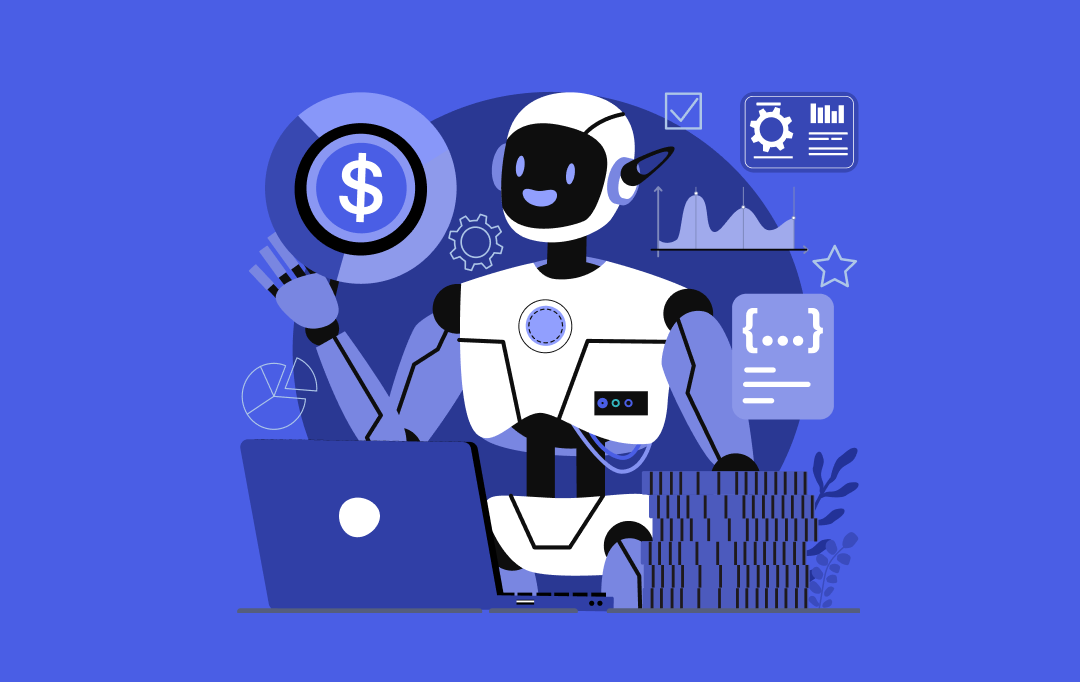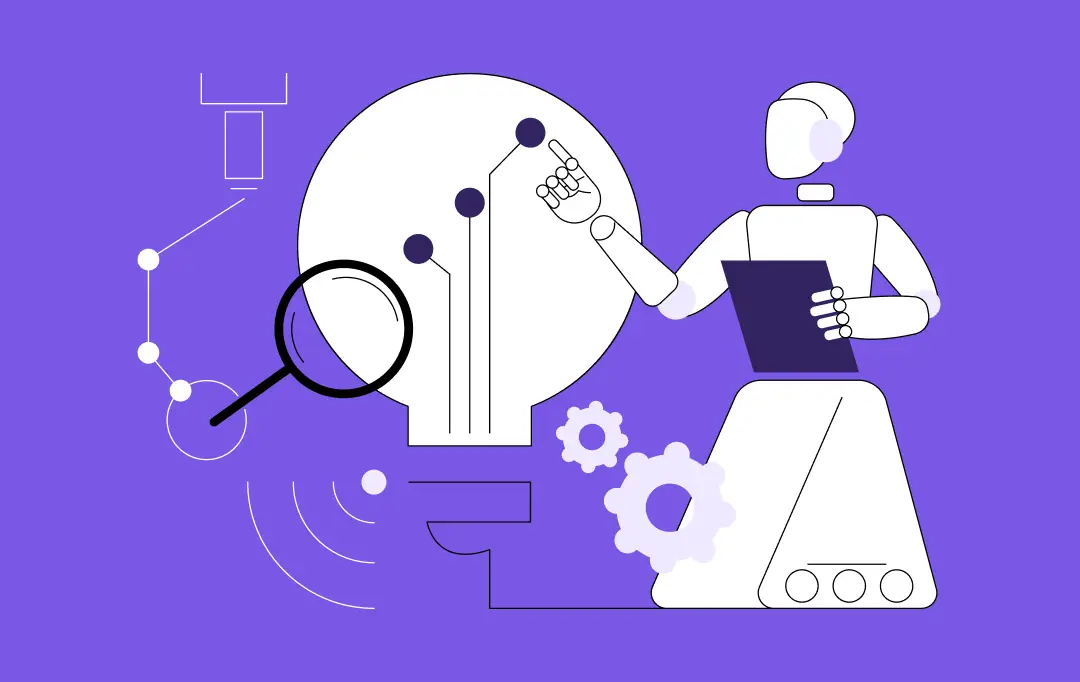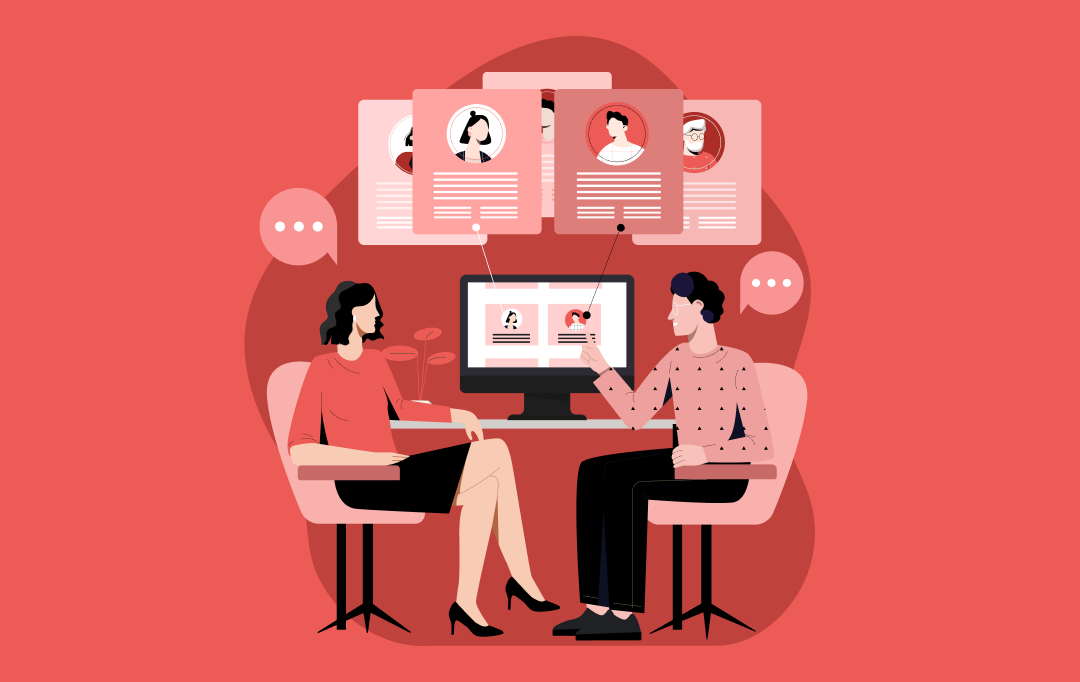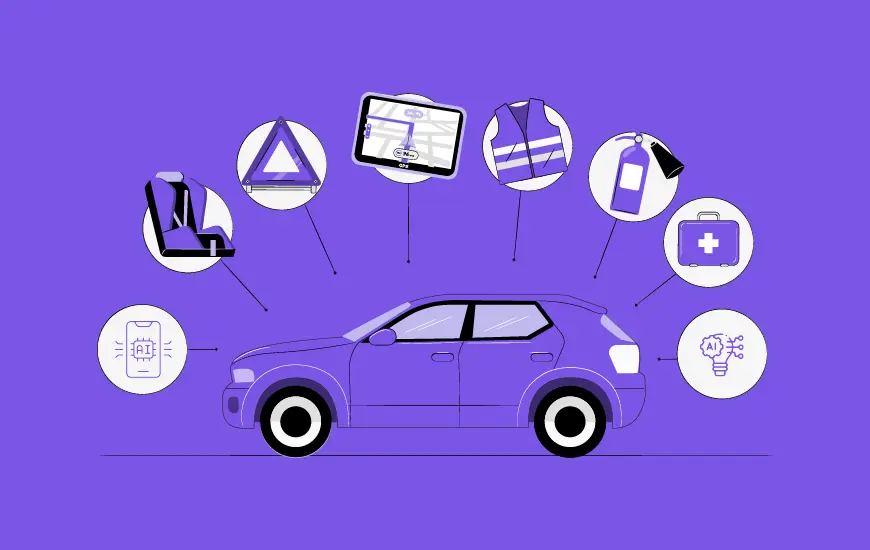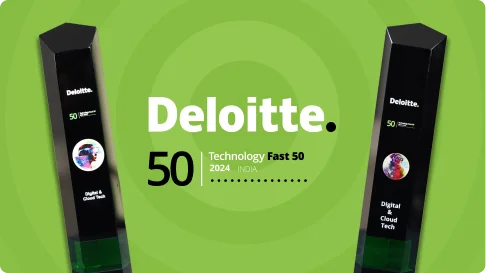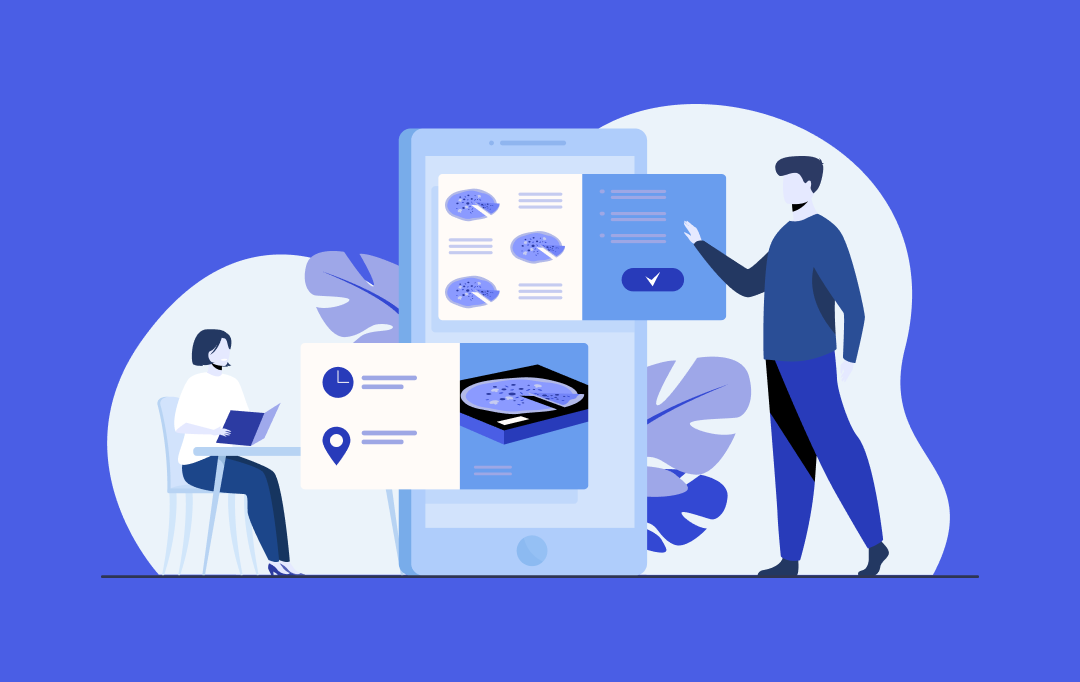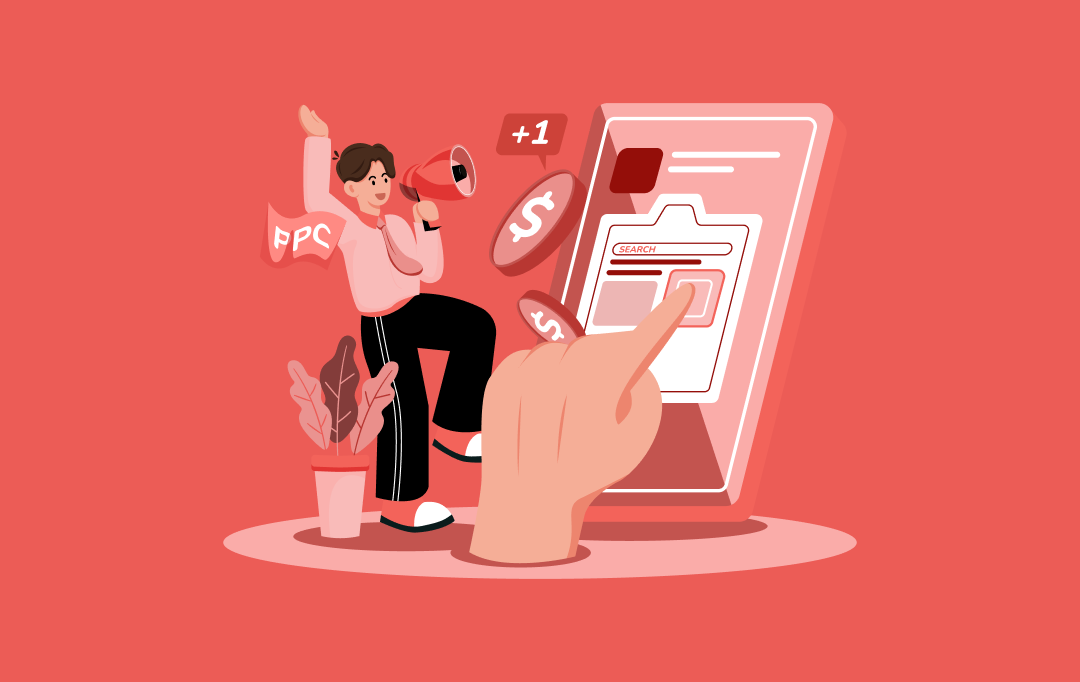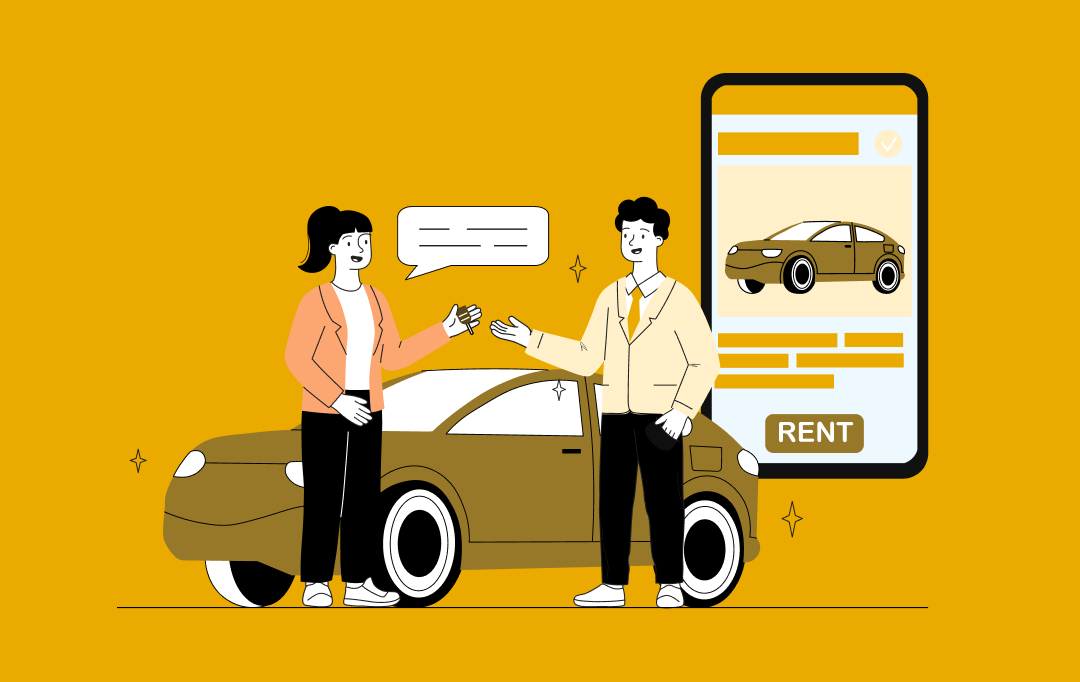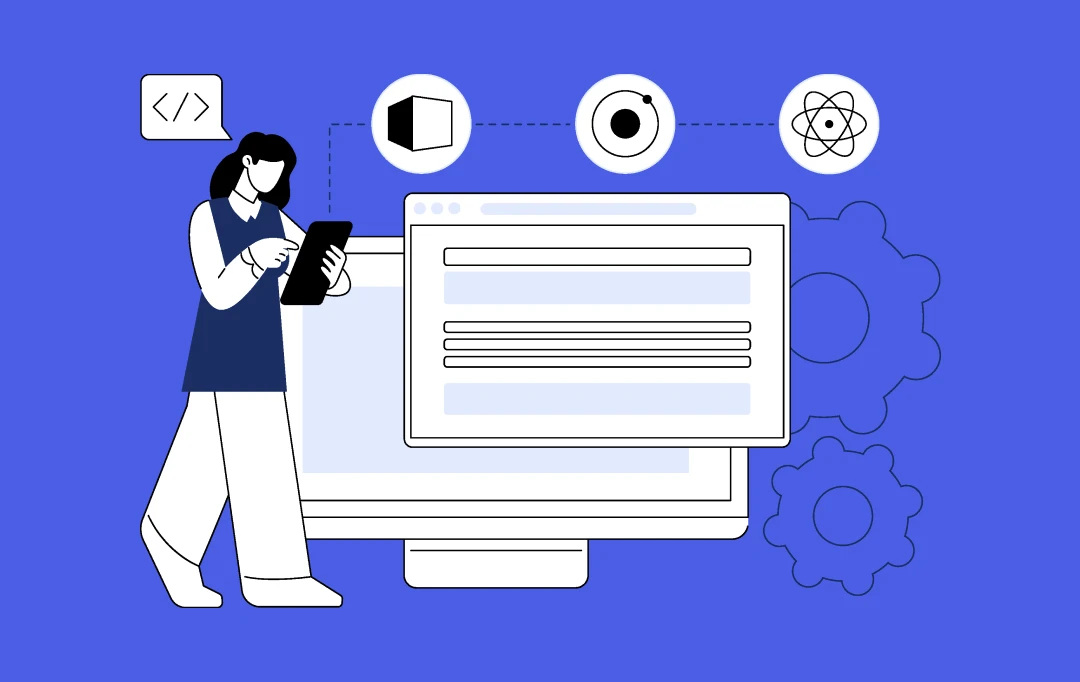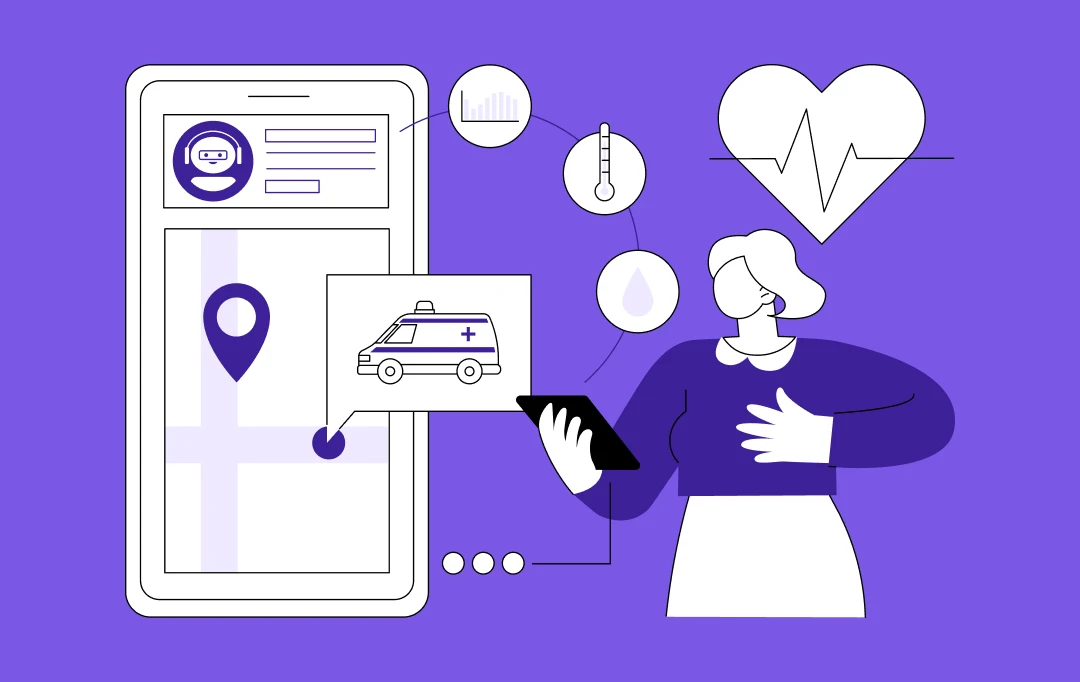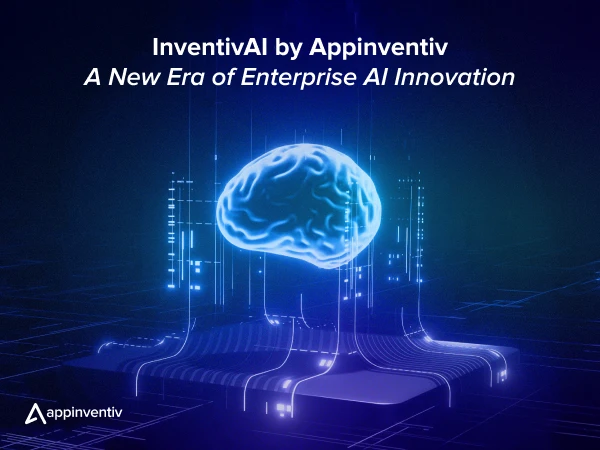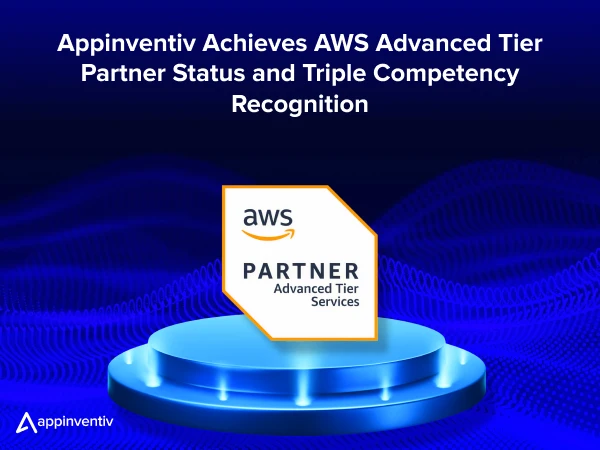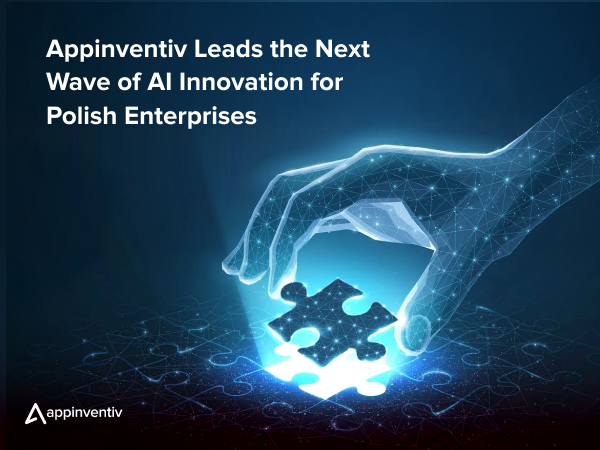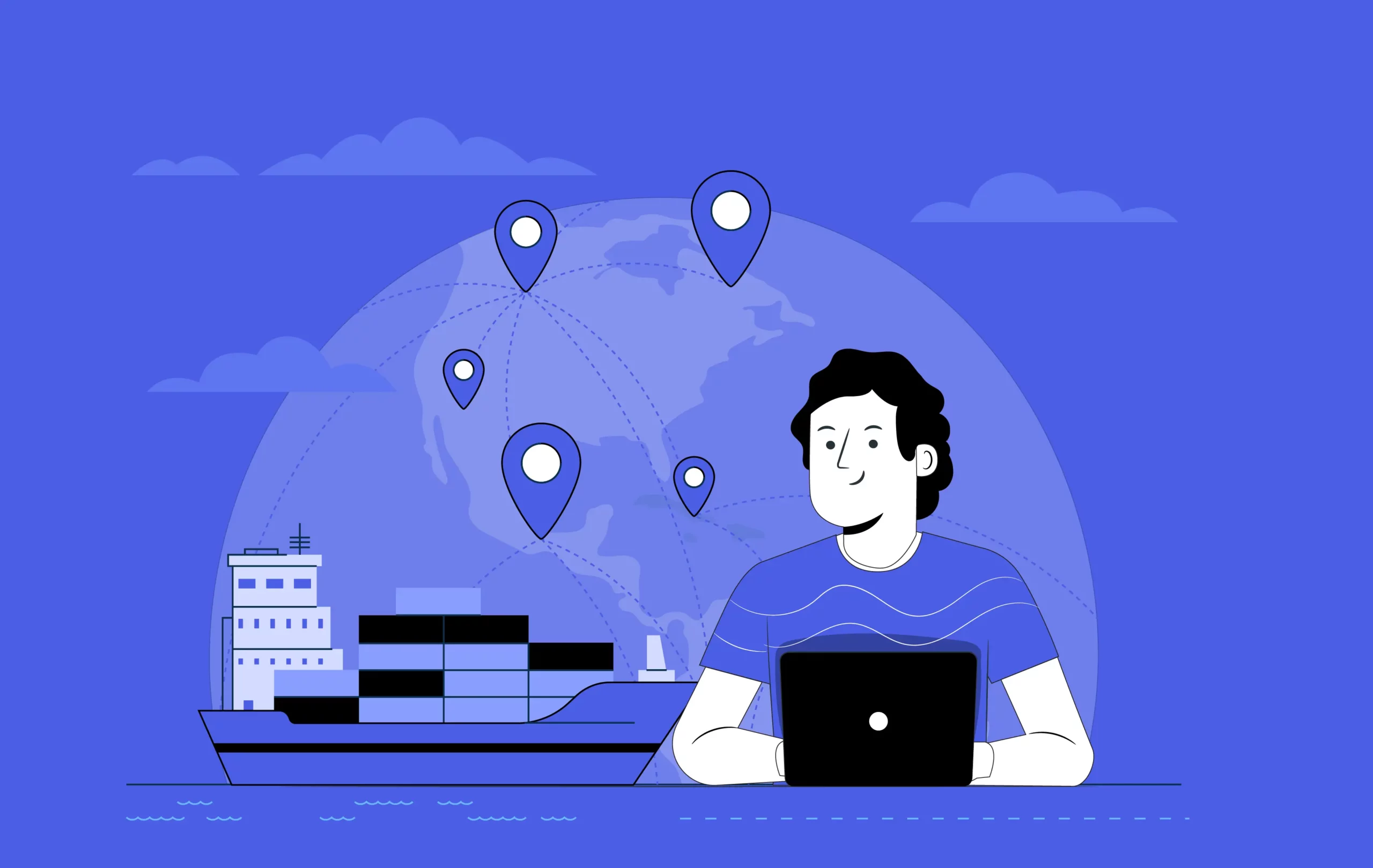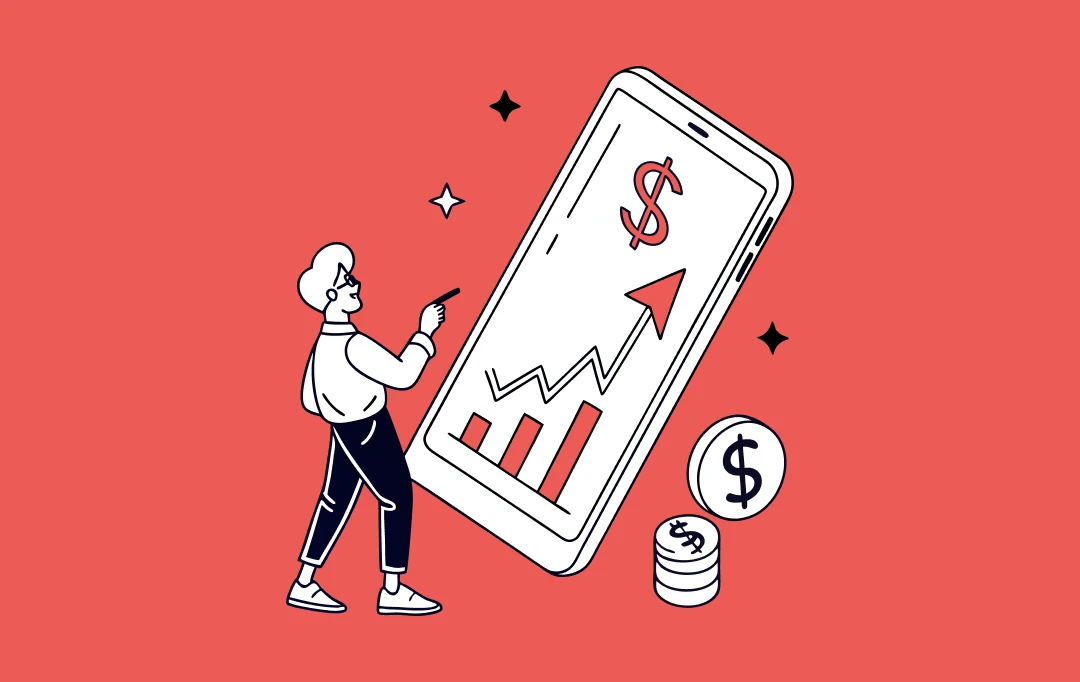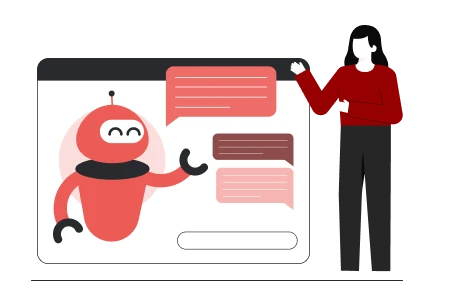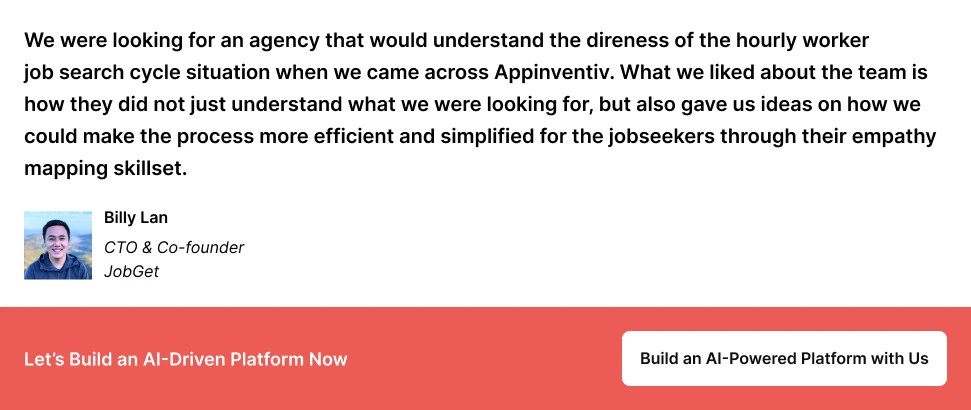- What Makes AI Personalization Different from Traditional Marketing?
- How AI Personalization Actually Works: The Technology Breakdown
- Machine Learning → Churn Reduction
- Computer Vision → Conversion Lift
- Predictive Analytics → Revenue Optimization
- Natural Language Processing (NLP) → CX Cost Reduction
- AI Personalization Governance: Managing Risk at Scale (Enterprise-Critical)
- 1. Data Consent & Minimization
- 2. Model Risk Management (MRM)
- 3. Bias Audits & Fairness Testing
- 4. Explainable Recommendations (XAI)
- 5. Security & Regulatory Readiness
- 6. Human-in-the-Loop Decisioning
- The Cross-Industry Power of AI Personalization: Transforming Industries
- Healthcare
- Finance
- Retail and eCommerce
- Travel and Hospitality
- Entertainment and Media
- How AI Personalization Benefits Smart Businesses
- Boosting Revenue and ROI of AI Personalization
- Improving Customer Loyalty and Retention
- Enhancing Operational Efficiency
- Best Practices for Implementing AI Personalization in Businesses
- Challenges in AI Personalization Implementation & Strategies to Overcome Them
- Data Privacy and Security
- Quality and Accuracy of Data
- Bias in AI Algorithms
- Real-World Examples of Companies Leveraging the Power of AI Personalization
- Sephora’s AI-powered Beauty Consultations
- Starbucks’ AI-Powered Barista
- Spotify’s Personalized Playlists
- YouTube’s Tailored Video Recommendations
- Amazon’s Personalized Product Recommendations
- Netflix’s Binge-Watching Engine
- The Future of AI Personalization: What Lies in the Years Ahead
- Embrace AI Personalization for Business Growth with Appinventiv
- FAQs
Key takeaways:
- AI personalization moves beyond simple categories to create unique, real-time customer experiences.
- The magic behind it all is technologies like machine learning and predictive analytics.
- From Spotify to Sephora, businesses in different industries are using AI to make things more personal and profitable.
- For it to work, businesses need to focus on ethical AI personalization, protecting privacy, and preventing bias.
Last Tuesday, I grabbed my phone during lunch break. Netflix immediately showed “Stranger Things 4” – exactly what I’d been meaning to watch. Then I switched to Amazon and found camping gear recommendations that matched my upcoming weekend trip perfectly. Spotify had already created a “Chill Tuesday” playlist that somehow captured my exact mood.
None of this was magic. It was AI personalization in consumer experiences working behind the scenes, and frankly, it blew my mind how accurate these systems have become. Here’s what caught my attention recently: 71% of consumers now expect personalized interactions, and 76% actually get frustrated when this doesn’t happen (Source: McKinsey). It simply means we’ve moved far beyond generic, one-size-fits-all marketing. Gone are those spray-and-pray marketing days where everyone got the same generic email blast.
Today’s consumers? They’re spoiled. And honestly, they should be. When Netflix can predict what show I want to watch better than my spouse can, that sets a pretty high bar for every other company out there.
What’s happening underneath all this is pretty sophisticated stuff. AI systems process millions of data points every second. They’re looking at your browsing patterns, purchase history, the time you spend looking at certain products, and even the weather in your area. Traditional personalization used to group people by age or zip code. Now? AI in consumer experience creates a unique profile for literally every single person. Let’s dig deeper.
In this blog, you’ll discover exactly how AI in consumer experience strategies work across different industries. I’ll show you real examples, actual numbers, and practical tactics you can implement. Whether you’re running a small business or leading digital transformation at a Fortune 500 company, there’s something here that’ll change how you think about your customers.
Are you ready to turn frustration into satisfaction?
What Makes AI Personalization Different from Traditional Marketing?
Remember the good old days of traditional marketing? Companies would group us into big, broad categories. If you were a “young parent,” you’d get ads for diapers. If you were a “sports fan,” you’d get emails about tickets. It was a simple, rule-based game.
But that’s yesterday’s news. Today’s AI in consumer experience is a whole different ballgame. It’s dynamic, predictive, and it works in real-time.
- Real-time processing capabilities: One of the standout features of AI personalization is its ability to process data in real time. With predictive analytics for personalization, businesses can adjust their strategies instantly based on user behavior. It learns from your every click, your every search, your every purchase. It processes this mountain of data instantly, giving you a uniquely tailored experience. For example, if a shopper abandons their cart, AI can trigger a personalized email and offer discounts to entice them back.
- Speed: The speed difference is incredible. Traditional systems might update customer segments once a month. AI systems? They’re adjusting recommendations while you’re still browsing the website. I watched this happen in real time at an eCommerce site. I looked at running shoes, then switched to looking at yoga mats. Within seconds, the product recommendations shifted to show athletic wear suitable for both activities.
- Scalability: Scale is another huge factor. AI in consumer experience platforms can handle millions of users simultaneously, each getting a completely unique experience.
These are the key differences when you compare AI personalization vs traditional marketing. One is a blunt instrument; the other is a precision tool.
Here’s a table that outlines the key differences between AI personalization and traditional marketing:
| Aspect | AI Personalization | Traditional Marketing |
|---|---|---|
| Data Utilization | Uses big data and advanced AI analytics to create personalized experiences based on individual behavior and preferences. | Relies on broad demographic data and segmented audiences without personal behavioral insights. |
| Customization | Highly tailored content and product recommendations, based on each user’s past interactions and preferences. | One-size-fits-all approach with generic ads, often not tailored to individual needs. |
| Real-Time Adaptation | Adjusts content and offers in real-time, responding immediately to consumer actions. | Changes in strategy take longer, with updates often occurring in batch campaigns. |
| Scalability | Can easily scale across millions of users with personalized content tailored to each one. | Struggles to scale, as personalizing for large audiences is time-consuming and resource-intensive. |
| Engagement | Creates deep, meaningful connections by understanding user needs and delivering highly relevant experiences. | Engagement is lower, as content isn’t directly relevant to individual preferences. |
| Automation | AI automates personalization at scale, reducing manual effort while increasing relevance and engagement. | Often relies on manual segmentation, requiring more time and resources for execution. |
| Targeting Accuracy | Uses advanced algorithms like machine learning to predict and meet individual needs with high accuracy. | Broad targeting methods that often miss out on the specific needs of individual customers. |
| Consumer Experience | Creates a continuous and relevant customer journey that evolves with the consumer. | Often fragmented, with inconsistent messaging across different channels and touchpoints. |
| Cost Efficiency | Offers long-term cost savings through automation, real-time insights, and reduced customer churn. | Requires continuous investment in broad campaigns and traditional advertising methods. |
How AI Personalization Actually Works: The Technology Breakdown
So, what’s powering all this? What makes AI personalization so intriguing and catches attention? It’s a group of smart technologies working together.
Machine Learning → Churn Reduction
ML models identify early churn signals by analyzing behavior patterns, enabling proactive retention campaigns before customers disengage.
Machine learning (ML) is the brain. It’s a set of algorithms that learn from huge amounts of data to detect patterns and predict what you might do next. The more data it gets, the smarter it becomes.
Content-based filtering takes a different approach. Instead of looking at other customers, it analyzes the actual characteristics of products you’ve shown interest in. If you’ve been buying organic skincare products, it’ll recommend other organic beauty items, even if they’re from brands you’ve never heard of.
Deep learning neural networks sound intimidating, but they’re basically pattern recognition on steroids. They can spot connections that humans would never notice. I saw this in action at a streaming service that realized customers who watched certain cooking shows were also likely to enjoy specific travel documentaries. The connection? Both featured Mediterranean culture. No human analyst would have made that link.
Computer Vision → Conversion Lift
Visual search, virtual try-ons, and image-based recommendations increase buyer confidence and directly improve conversion rates.
Computer vision services helps AI “see” and interpret images. Customers can now upload photos and find similar products instantly. This is used for those cool virtual “try-on” features for makeup or clothes that many retailers now offer.
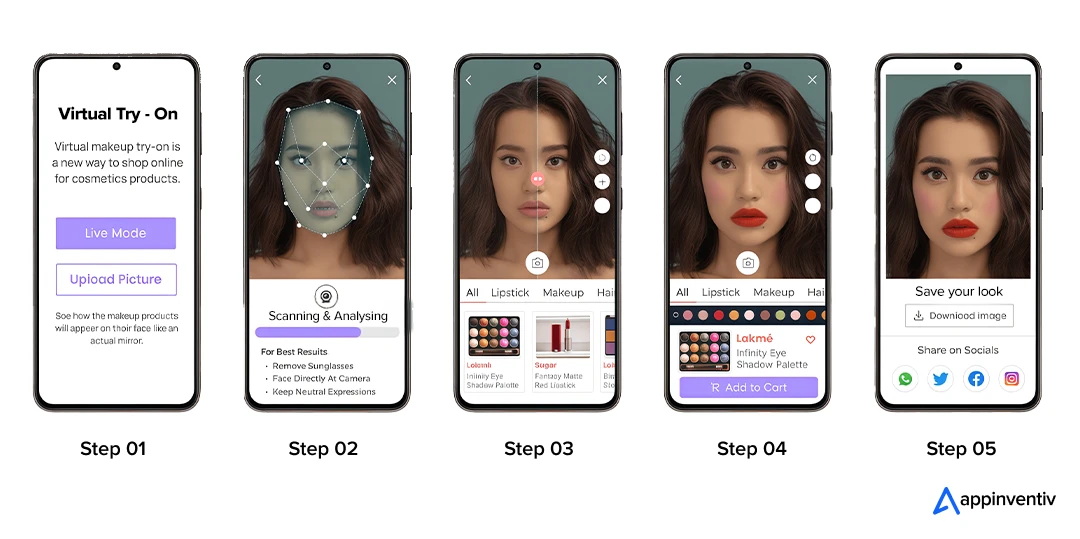
Predictive Analytics → Revenue Optimization
Predictive models anticipate demand, optimize pricing, and surface the right offer at the right moment.
Predictive analytics for personalization uses data to guess what’s coming. A retailer can use it to figure out which products to recommend or how much to charge. It’s like having a crystal ball for customer behavior.
Recommendation engines are what you see most often. These are the systems that suggest movies on Netflix, products on Amazon, or new songs you’ll love. They are a powerful tool for boosting conversions through AI.
Natural Language Processing (NLP) → CX Cost Reduction
AI-powered chatbots and sentiment analysis reduce support workloads while improving first-contact resolution rates.
Natural Language Processing (NLP) lets computers understand our language. This is what makes a chatbot feel like you’re talking to a real person. It analyzes customer feedback and even understands the emotion behind a text message. This technology is a game-changer for NLP in personalized customer interactions.
AI personalization technologies are not innovation projects—they are profit, retention, and risk-control engines when deployed correctly.
AI Personalization Governance: Managing Risk at Scale (Enterprise-Critical)
AI personalization at scale is no longer just a growth lever—it’s a governance and risk discipline. As personalization systems influence pricing, recommendations, eligibility, and customer journeys, enterprises must ensure these systems remain transparent, compliant, and bias-safe.
Here’s what a structured AI personalization governance framework looks like in practice:
1. Data Consent & Minimization
AI personalization must begin with explicit, auditable consent architectures.
- Collect only what is necessary for personalization outcomes
- Implement consent-based feature activation (opt-in personalization tiers)
- Separate sensitive attributes from decision pipelines
This reduces regulatory exposure while building long-term customer trust.
2. Model Risk Management (MRM)
Personalization models are dynamic, continuously learning systems—and therefore carry model drift and decision risk.
- Define acceptable model behavior thresholds
- Monitor performance decay, bias drift, and anomaly spikes
- Maintain versioned model documentation for audits
This approach mirrors financial MRM practices now increasingly expected in AI-led consumer systems.
3. Bias Audits & Fairness Testing
Unchecked personalization can unintentionally reinforce exclusion or discrimination.
- Run scheduled bias and fairness evaluations across demographics
- Test recommendation parity and outcome consistency
- Use diverse training datasets and synthetic data where needed
Fair personalization isn’t just ethical—it protects brand reputation and revenue.
4. Explainable Recommendations (XAI)
Black-box personalization is a liability at enterprise scale.
- Enable explainability layers that justify recommendations
- Provide internal transparency for compliance and audit teams
- Offer user-facing explanations where legally or commercially required
Explainability increases trust with regulators, customers, and internal stakeholders.
5. Security & Regulatory Readiness
AI personalization systems must be built with privacy-by-design principles.
- Encryption of behavioral and contextual data
- Role-based access controls for model and data layers
- Readiness for GDPR, CCPA, and upcoming AI regulations
Compliance should be a design input, not a retrofit.
6. Human-in-the-Loop Decisioning
Not every decision should be fully automated.
- Human review for high-impact personalization outcomes
- Escalation paths for anomalies or edge cases
- Clear ownership between product, risk, and AI teams
This balance ensures agility without losing accountability.
Enterprise Insight:
Companies that treat AI personalization as a governed system—not a feature—scale faster, safer, and with fewer regulatory disruptions.
The Cross-Industry Power of AI Personalization: Transforming Industries
The impact of AI personalization in consumer experiences is everywhere you look. It’s not just a fancy tool for tech giants.
Healthcare
AI is starting to move away from a one-size-fits-all approach to medicine. Doctors are now using AI to personalize treatment plans based on a patient’s unique genetic code and health history. It’s also powering patient portals that give out personalized health advice and reminders.
For instance, Appinventiv developed DiabeticU, an AI-driven healthcare app that uses advanced data analytics to provide personalized health insights. By continuously analyzing patient data from health records and wearable devices, the app offers customized treatment suggestions and lifestyle amendments. The result is a significant improvement in patient well-being and an enhanced quality of life.”
Business Impact:
- Improved treatment adherence through personalized interventions
- Reduced readmission rates using predictive personalization
- Bias-controlled decisioning ensures ethical patient outcomes
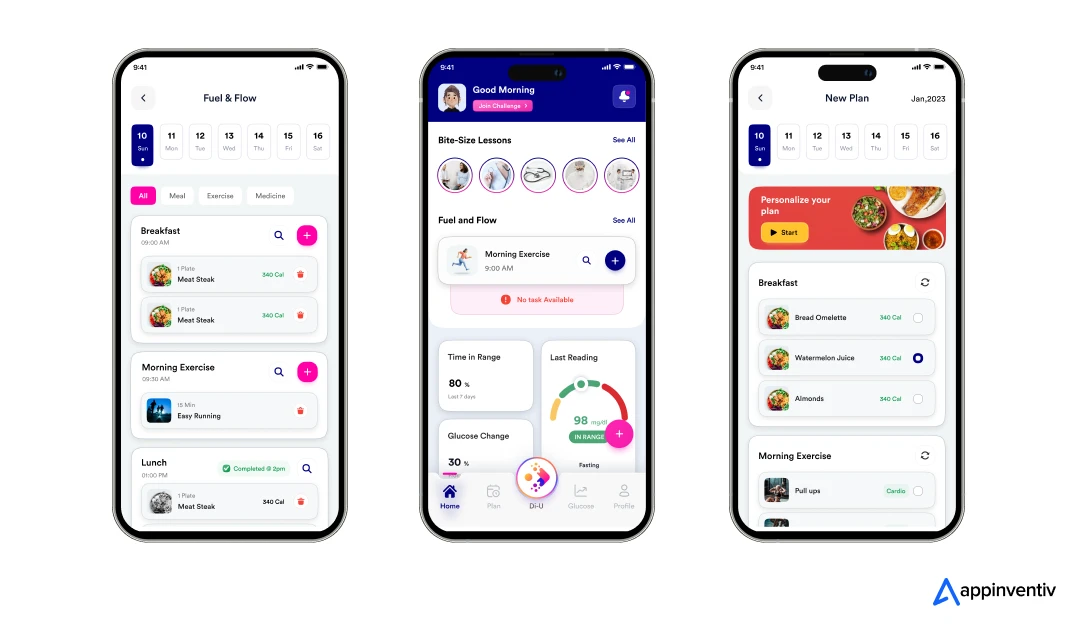
Finance
Banks are using AI to offer personalized financial advice and credit card offers. Additionally, fraud detection is where AI agents really shine. The system learns your normal spending patterns down to incredibly specific details. It knows you usually buy coffee around 8 AM near your office, shop for groceries on Sunday afternoons, and make larger purchases on weekends. When someone tries to use your card for a $500 electronics purchase at 3 AM in a different state, the system flags it instantly.
Business Impact:
- +25% engagement on personalized financial offers
- Real-time fraud detection lowers financial risk exposure
- Explainable AI models support regulatory audits and customer trust
Retail and eCommerce
Retailers are increasingly adopting AI-driven customer personalization to enhance the shopping experience. For example, Amazon has taken AI personalization to a whole new level.
AI personalization in eCommerce at Amazon isn’t just about showing you products you might like. They’ve rebuilt their entire business model. Their recommendation engine generates 35% of total sales, according to McKinsey research. That’s not a small feature – that’s literally more than one-third of their revenue. Using machine learning for customer segmentation allows retailers to create super-specific customer groups, leading to more sales.
Business Impact:
- +15–30% AOV through AI-driven recommendations
- –20% customer churn via predictive personalization
- Real-time pricing governance reduces margin leakage and over-discounting
Also Read: How AI in Retail Improves Shopping Experiences
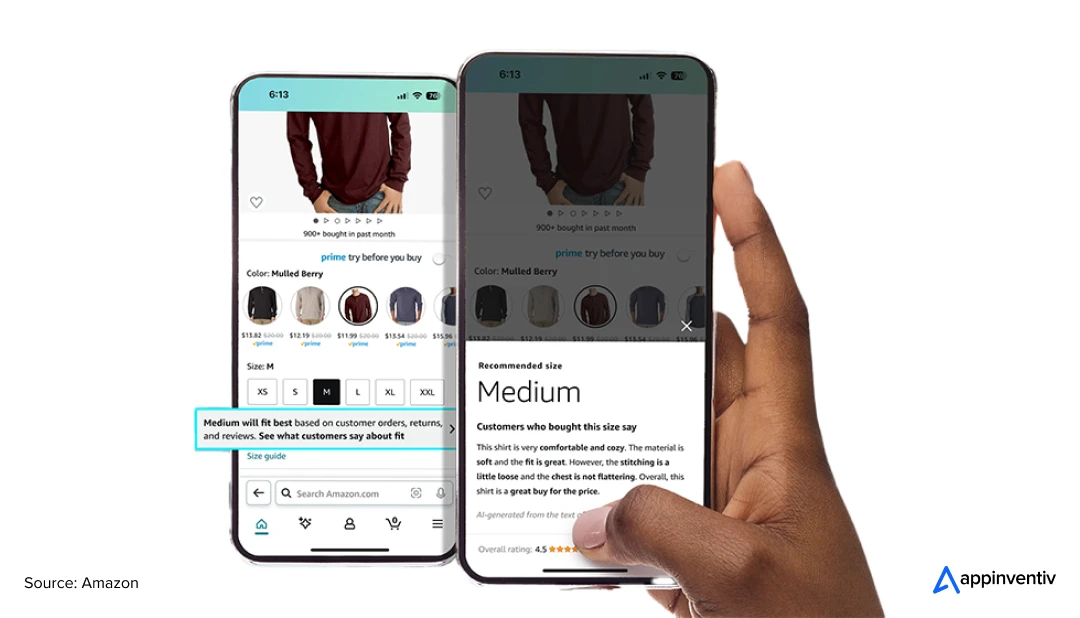
Travel and Hospitality
Travel personalization has come so far. Have you ever seen a travel site suggest a hotel in a specific city right after you searched for flights there? That’s AI. It also helps companies offer personalized packages and uses chatbots to provide instant customer service.
Moreover, AI has made loyalty programs incredibly sophisticated. They don’t just reward you for spending money – they personalize rewards based on your preferences and behavior. Some people prefer airline miles, others want hotel upgrades, and others just want cash back. The AI figures out what motivates each individual customer.
Business Impact:
- Higher booking conversion through personalized offers and dynamic pricing
- Lower guest churn via AI-driven itinerary and service recommendations
- Governed personalization ensures compliance, prevents over-discounting, and manages data privacy
Entertainment and Media
This industry is a master of personalization. Netflix’s algorithm, for example, is so good at recommending shows that it’s become a core part of its business model. And we’re seeing more and more generative AI in personalization, where AI can create brand-new content experiences tailored just for you.
Generative AI in personalization is opening up new possibilities in entertainment. Some platforms are experimenting with AI-generated content summaries, personalized trailers, and even custom playlist descriptions that match your sense of humor.
Business Impact:
- Higher content consumption per user
- Lower subscription churn via intent-based recommendations
- Governed algorithms protect against filter bubbles and content bias
How AI Personalization Benefits Smart Businesses
When you invest in AI personalization in consumer experiences, you’re not just adding a cool feature—you’re building a smarter business. The benefits go straight to the bottom line. It’s all about creating a ripple effect: a better customer experience leads to more sales, which leads to happier customers who stick around. This is the new formula for growth.
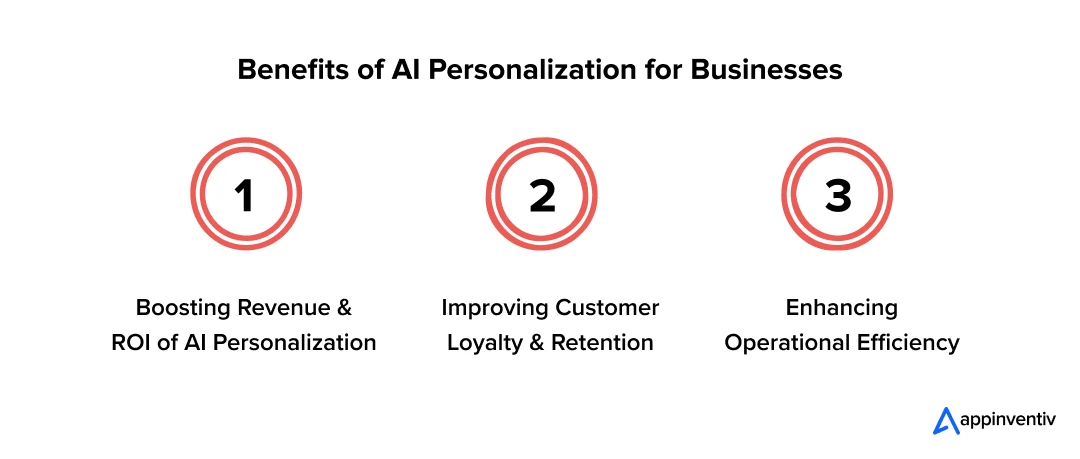
Boosting Revenue and ROI of AI Personalization
Let’s talk numbers. One of the biggest wins for businesses is a significant jump in revenue. Why? Because when you show customers what they actually want, they’re much more likely to buy. AI-powered recommendation engines are wizards at this, driving sales through smarter product suggestions and dynamic pricing.
This is the core of boosting conversions through AI. You’re not just sending out generic offers; you’re sending the right offer to the right person at the right time.
Improving Customer Loyalty and Retention
Ever feel like a brand is listening to you? That feeling of being understood is what builds loyalty. When a company uses AI to create a truly personalized journey, it makes customers feel valued.
This emotional connection fuels customers’ trust and reduces customer churn with AI. By anticipating needs and making every interaction relevant, businesses can transform one-time buyers into loyal, long-term advocates. A customer who feels like a brand knows them is a customer who will keep coming back.
Enhancing Operational Efficiency
Personalization isn’t just about the customer-facing side. It is also about making your internal operations much smoother. AI automates many tasks that used to be manual and time-consuming.
For instance, AI chatbots can handle a large percentage of customer support inquiries instantly. Or marketing campaigns that are automatically optimized based on real-time data, cutting out wasteful spending. Instead of spending countless hours on broad campaigns, your team can focus on more strategic, high-value work. This is how AI not only drives growth but also makes your business smarter and more agile.
Best Practices for Implementing AI Personalization in Businesses
So, you’re ready to dive into the world of AI personalization. That’s great! But how will you do it right? Simply adding a new technology won’t ensure success. The real magic happens when you implement it strategically. To get the most out of AI personalization in consumer experiences, you need a thoughtful, step-by-step approach. Here you go:
For Businesses
- Start with a clear goal: Don’t just jump on the trend. What do you actually want to achieve? More sales? Happier customers? A good strategy starts with a clear objective.
- Invest in good data: AI is only as smart as the data it learns from. Make sure your data is clean, accurate, and easy to access.
- Prioritize privacy: This is a big one. Be completely open with your customers about the data you collect and why. Follow all the rules, like GDPR and CCPA.
- Test and learn: The world changes fast. You need to constantly test different strategies and see what works. It’s a journey, not a destination.
- Keep humans in the loop: AI should help your team, not replace it. Human oversight is essential to make sure everything is fair and works as it should.
For Consumers
- Know your privacy settings: Take a few minutes to look at the settings on your favorite apps. You might be surprised at what you can control.
- Manage data sharing: Many platforms let you choose what data you share. Take advantage of it.
- Understand what’s happening: When you see a personalized ad, just be aware that it’s the result of an algorithm. This is an important part of understanding AI and the future of consumer privacy.
- Learn a little about the tech: A little bit of digital literacy goes a long way. The more you know, the more empowered you are.
Expert Insight: When implementing AI personalization in businesses, businesses must consider these consumer-focused implementation steps. This little consideration will help you build the right strategy that will go a long way in attracting and retaining customers.
Challenges in AI Personalization Implementation & Strategies to Overcome Them
Though AI in businesses is known to transform operations and consumers’ experiences, it’s not all smooth sailing. There are real challenges to tackle.
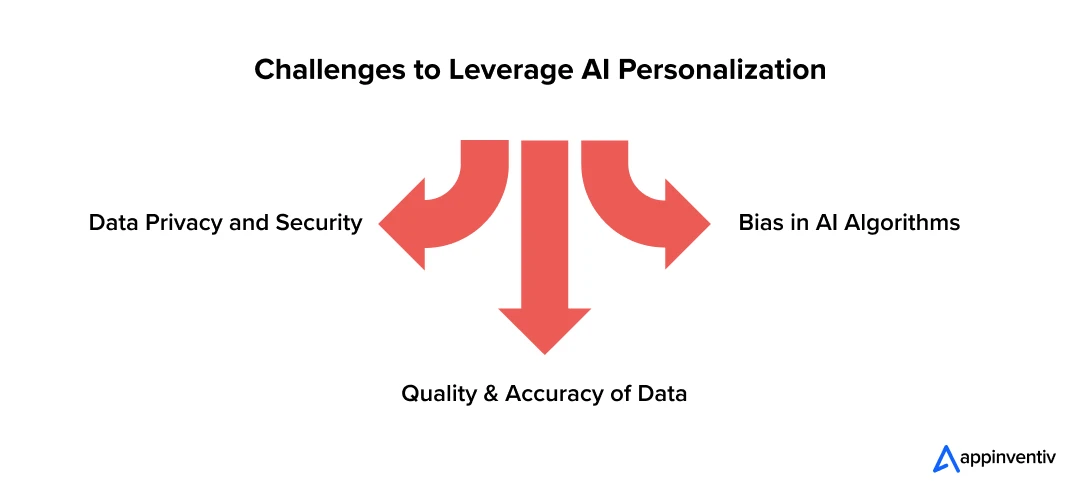
Data Privacy and Security
Challenge: Privacy has become the biggest challenge in personalization, and honestly, it’s getting more complex every year. The more data a company has, the more it has to protect.
Solution: The solution is to build a system with a “privacy-by-design” approach. Data protection isn’t an afterthought; it’s a core feature.
Quality and Accuracy of Data
Challenge: Data quality problems can destroy even the best personalization algorithms. Garbage in, garbage out – it’s an old saying that’s absolutely true for AI systems. If the data you feed an AI is garbage, the recommendations will be, too.
Solution: AI personalization in consumer experiences requires constant data monitoring and validation. Automated quality checks can catch obvious errors, but you need human reviewers to identify subtle problems. Regular data audits help maintain system accuracy over time.
Bias in AI Algorithms
Challenge: Algorithmic bias is a serious issue that requires ongoing attention. AI can learn the biases that are already in our world. For example, a hiring algorithm could unintentionally favor one group over another if the data it learned from was skewed.
Solution: The solution is to use diverse data and constantly audit your AI models to make sure they are fair. You should apply the principles of responsible AI to actively identify and correct discriminatory patterns in AI systems.
Real-World Examples of Companies Leveraging the Power of AI Personalization
We’ve talked enough about what AI personalization is and why it matters. Now, let’s see how it works in the real world. From streaming giants to global retailers, these companies are rewriting the rules of customer engagement, proving that an intelligent, personalized approach is the key to creating a truly loyal following. Here are some of the best examples of AI personalization in action:
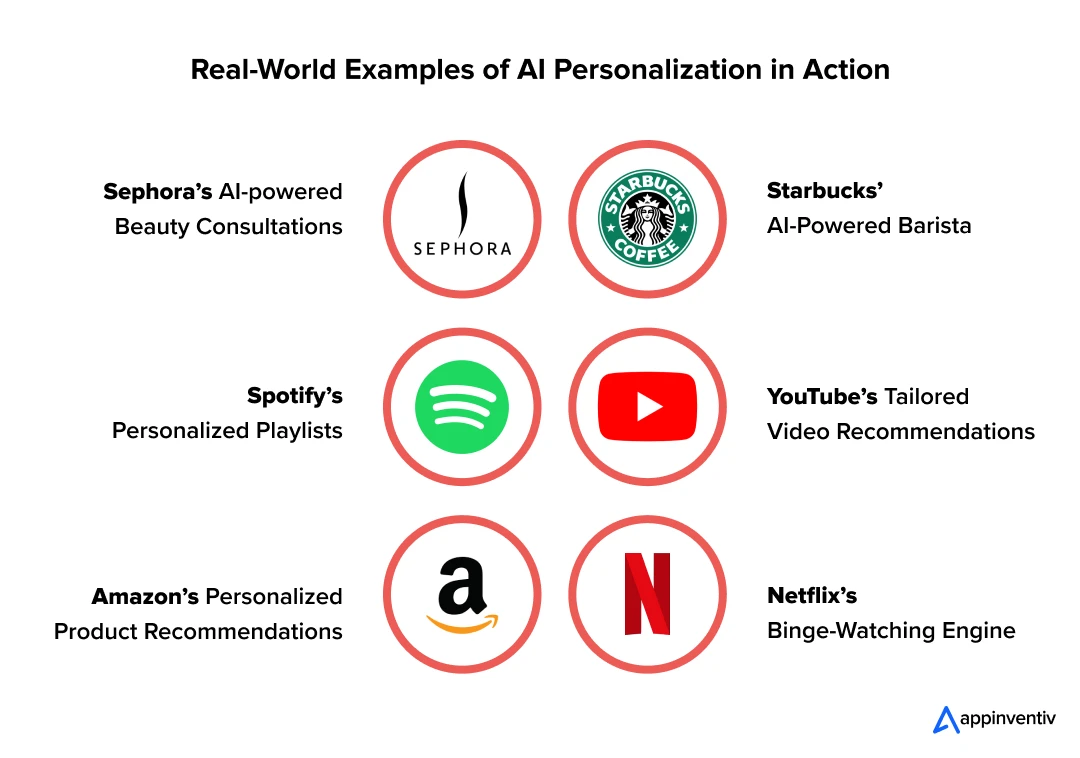
Sephora’s AI-powered Beauty Consultations
Sephora’s “Virtual Artist” uses augmented reality to let you “try on” makeup from your phone. It’s a great example of how AI can enhance the shopping experience, drive sales and increase conversion rates.
Starbucks’ AI-Powered Barista
Starbucks has become a master of loyalty, and much of that credit goes to its AI-powered platform, “Deep Brew.” The company’s “Deep Brew” AI platform analyzes everything from your past orders to the local weather to send you hyper-personalized offers through its app. It’s a major driver of customer loyalty.
Spotify’s Personalized Playlists
Its “Discover Weekly” and “Made for You” playlists are famous for a reason. They use machine learning services and collaborative filtering to find songs you’ll love. The company’s new AI Playlist feature, now in beta, lets users create playlists with conversational prompts like “a playlist for running in the rain.”
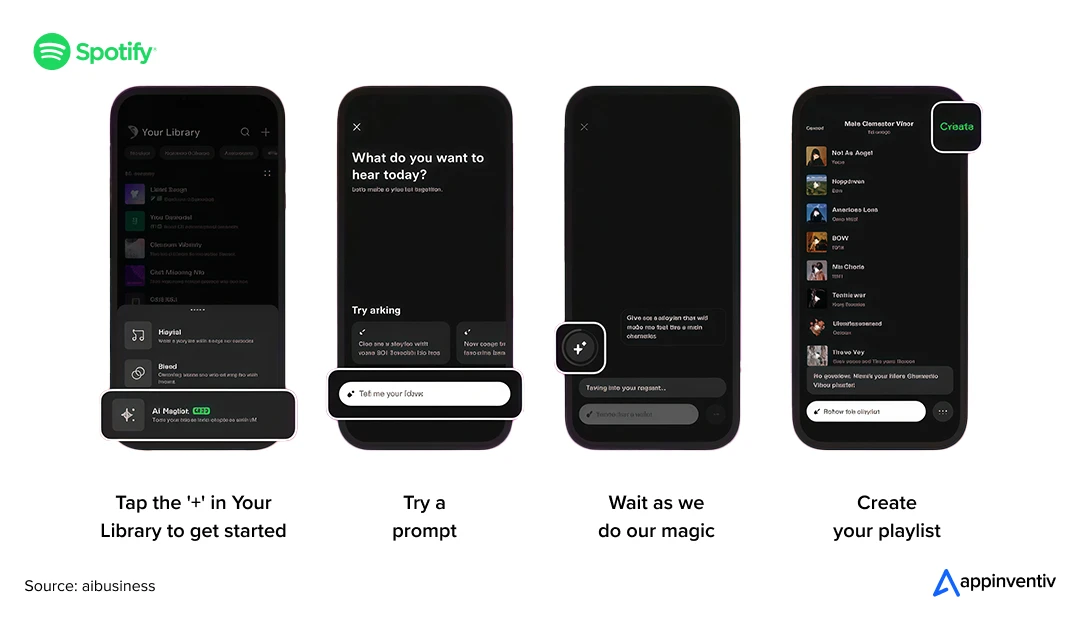
YouTube’s Tailored Video Recommendations
YouTube processes over 1 billion hours of video daily, and most of that viewing time comes from personalized recommendations. The recommendation algorithm is a masterpiece of personalization. It looks at your watch history and what other people with similar interests are watching to keep you on the platform for hours on end. This shows just how AI shapes consumer behavior.
Amazon’s Personalized Product Recommendations
Amazon’s recommendation engine is legendary. It uses a mix of your own Browse and what people like you have bought to suggest products. It’s a huge reason for the company’s success and a perfect example of AI personalization in eCommerce. The company’s new AI shopping assistant, “Rufus,” even answers open-ended product questions to refine recommendations through conversational prompts.
Netflix’s Binge-Watching Engine
Netflix’s success is inseparable from its powerful recommendation engine. The platform analyzes everything you do; what you watch, how long you watch it, what you search for, and what you rate. The streaming giant uses this data to personalize nearly every aspect of your experience, from the recommended movies and TV shows on your homepage to the images shown for each title.
This is a prime example of how artificial intelligence in personalized marketing works to keep users hooked and subscribed.
Our AI governance & personalization architects help enterprises deploy compliant, bias-safe, revenue-driven personalization systems.
The Future of AI Personalization: What Lies in the Years Ahead
The future of personalization is already here. Generative AI in personalization is just the beginning. We’ll see a move toward even more predictive, anticipatory experiences. Imagine a world where a smart assistant knows you’re about to run out of coffee and adds it to your cart. Here are some of the emerging AI trends that will redefine consumer behavior
Augmented reality is opening up new possibilities for personalized experiences. Furniture retailers like IKEA let you visualize products in your actual living space. Fashion brands offer virtual try-on experiences that account for your body type and style preferences. Beauty brands can show you how different makeup looks would appear on your face in various lighting conditions.
Also Read: How We Developed an Intelligent ERP System for IKEA
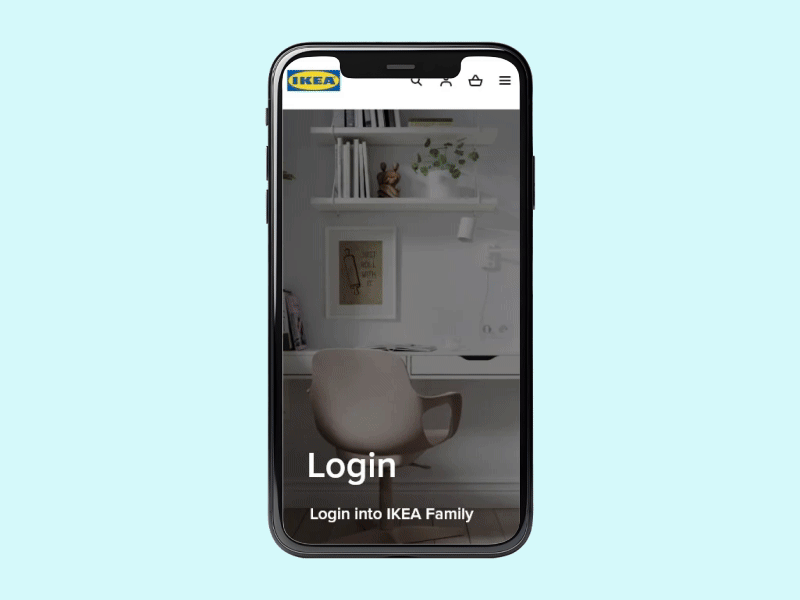
The Internet of Things (IoT) is creating new data sources for personalization. Smart home devices understand your daily routines, preferred temperatures, and entertainment habits. Connected cars know your driving patterns and can suggest optimal routes, stops, and even music based on your typical preferences during different types of trips.
Predictive personalization is getting scary good. Systems can anticipate your needs based on life events, seasonal patterns, and behavioral trends. I’ve heard of retailers who send new parent care packages before customers realize they need them, based on subtle changes in shopping patterns.
Artificial intelligence in personalized marketing is becoming more sophisticated across multiple channels simultaneously. Instead of managing separate campaigns for email, social media, and web advertising, AI systems coordinate messaging across all touchpoints to create cohesive, personalized customer journeys.
Cross-platform identity resolution is creating unified experiences across devices and services. Your preferences on your phone inform recommendations on your TV. Your smart home settings influence suggestions in your car. The boundaries between different platforms are disappearing.
Undoubtedly, the new approaches will enable personalization without compromising individual privacy. Thai will help build trust and enable even better personalized experiences.
Embrace AI Personalization for Business Growth with Appinventiv
In a world full of noise, AI personalization in consumer experiences is the key to cutting through and making a real connection. It’s no longer a nice-to-have; it’s a must-have. However, building these sophisticated systems isn’t easy. It requires the expertise of an experienced AI consulting company that can show you the right path, pick up the potential barriers, as well as smooth out the journey of AI implementation for personalized marketing.
That’s where Appinventiv comes in. As a leading provider of AI Development services for many global brands like Mudra, JobGet, Gurushala, and more, we are here to help you create smart, scalable, and ethical AI solutions that drive real growth.
Ready to transform your customer experiences through AI personalization? Reach out to us today and discuss your personalization strategy. Our team of 1600+ tech wizards will help you build systems that not only drive business growth but also create genuine value for your customers.
FAQs
Q. How does AI personalize shopping experiences?
A. AI personalizes shopping by analyzing customer data like previous purchases, browsing habits, and even social media activity to recommend products or services.
Q. What data is used for AI personalization?
A. It takes a lot of data to make a perfect recommendation. AI personalization in consumer experiences pulls data from a few different places to build a detailed picture of you:
- Behavioral Data
- Transactional Data
- Demographic Data
- Contextual Data
Q. Is AI personalization invading privacy?
A. While AI needs data to function, ethical companies are transparent about what they collect and why. They also give you control over your data. Good ethical AI personalization should always find a balance between giving you an incredible experience and respecting your privacy.
Q. What are some of the best AI tools for customer personalization?
A. So many companies are getting in on this. Some of the most popular tools include:
- Dynamic Yield: This is a big one for personalizing websites and apps in real-time.
- Optimizely: Known for its powerful A/B testing and experimentation features.
- Salesforce Einstein: This platform uses AI to help sales, service, and marketing teams deliver smarter, more personalized experiences.
Many businesses also build their own custom AI solutions tailored to their unique needs.
Q. What are some real-world examples of AI personalization in big brands?
A. You interact with AI personalization every single day, often without even thinking about it. Here are some of the most famous examples:
- Spotify: Their “Discover Weekly” and “Made For You” playlists are the gold standard for music recommendations.
- Netflix: Almost everything you see on the platform, from the shows to the thumbnail images, is personalized just for you.
- Amazon: Their legendary recommendation engine is famous for suggesting products.
- Starbucks: The “Deep Brew” platform sends you personalized offers and suggestions through their mobile app based on what you like and the time of day.


- In just 2 mins you will get a response
- Your idea is 100% protected by our Non Disclosure Agreement.
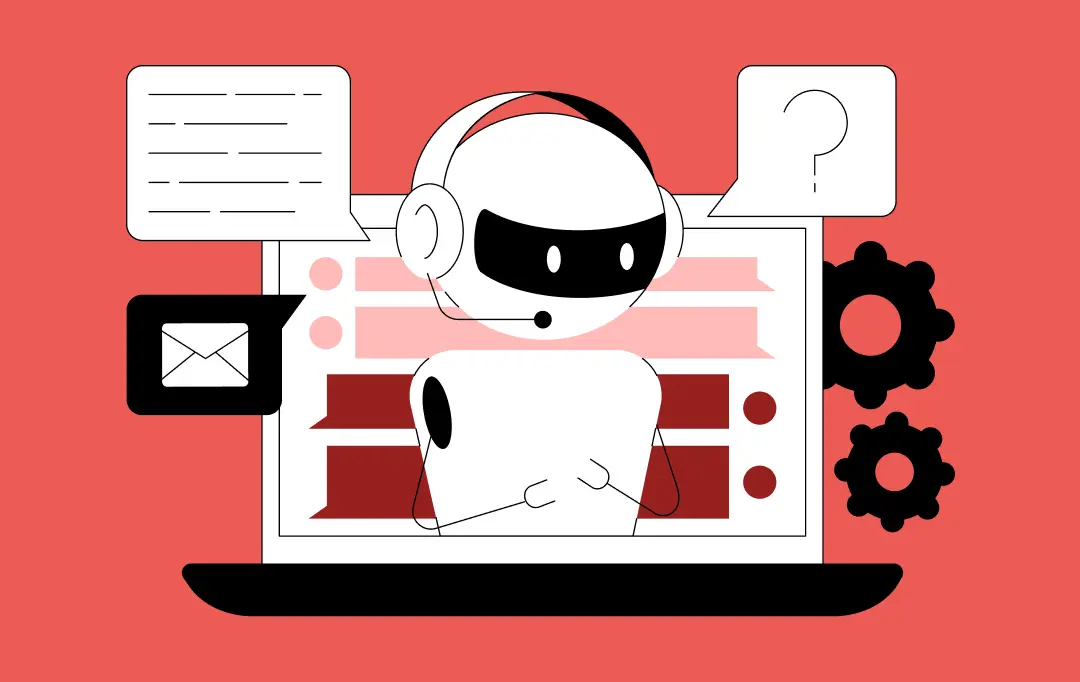
How to Build a Custom Multilingual Chatbot? Features, Process, Costs
Key takeaways: Multilingual Chatbots Drive Revenue Growth: Companies see higher conversion rates when customers can interact in their native language, with nearly 75% of global customers preferring to buy from websites in their preferred language. Beyond Translation to Cultural Intelligence: Successful implementations require cultural adaptation, not just language translation. Systems must understand context, emotion, and…
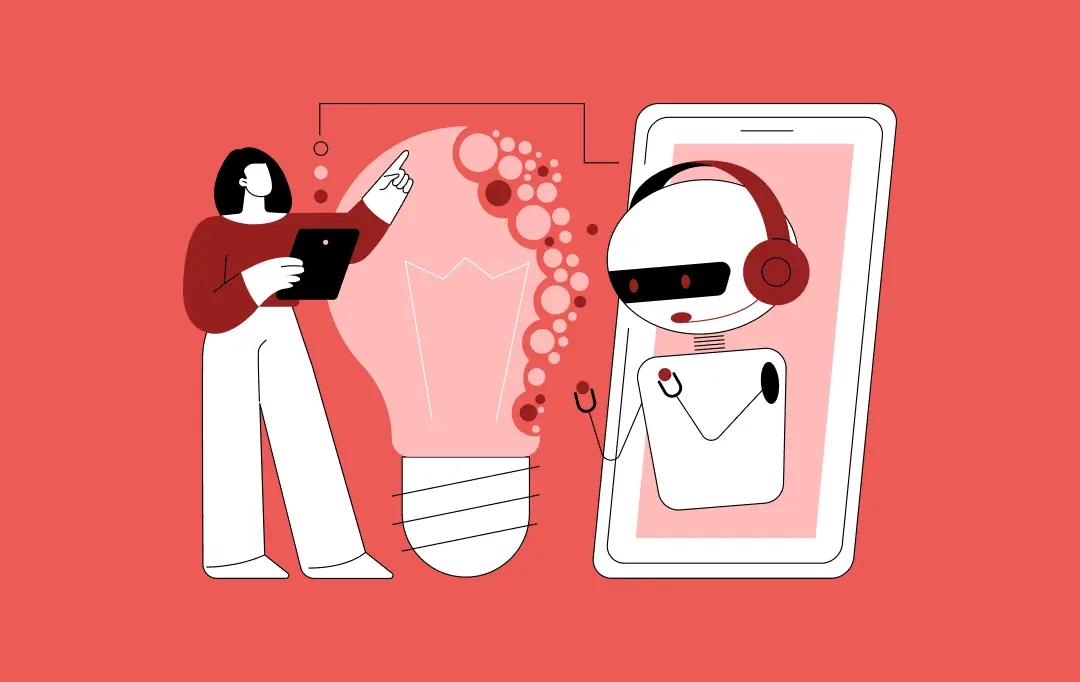
How Much Does It Cost to Build an AI App in Dubai?
Key takeaways: AI app costs in Dubai typically range from AED 80,000 for simple builds to AED 800,000+ for enterprise systems. Dubai is past AI experimentation, and not investing now means catching up later at higher cost. The real budget is driven by data, integrations, architecture, and compliance, not just app features. Hidden costs like…
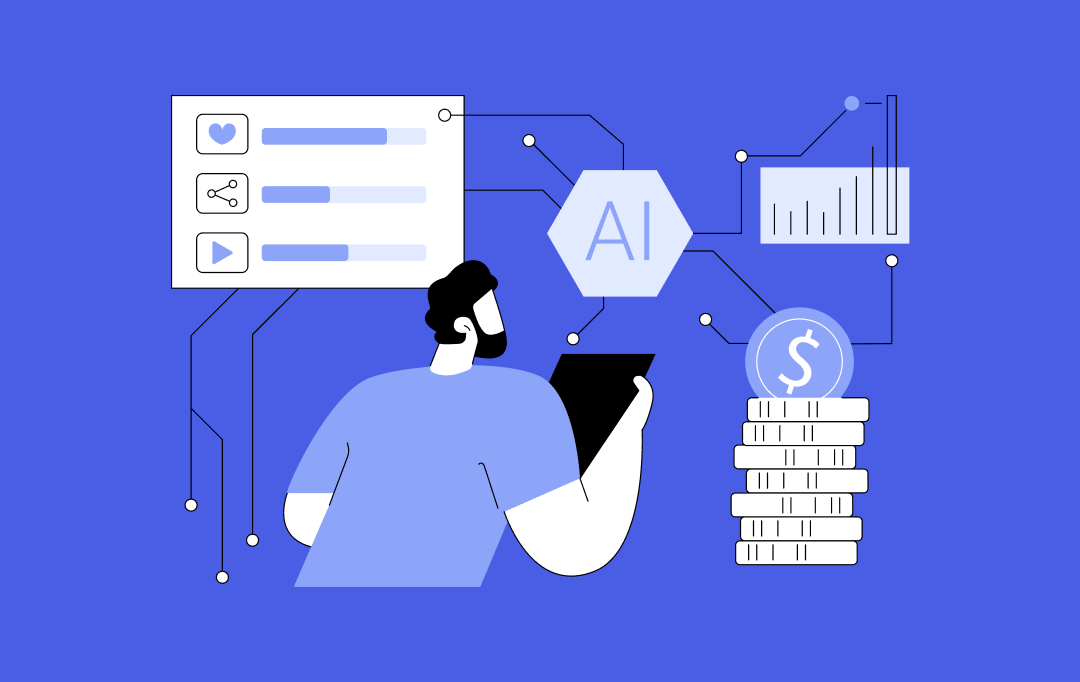
How AI Tokenization is Enabling Secure and Transparent Asset Ownership in 2026
By 2026, AI tokenization has moved beyond early-stage experiments and pilot projects. Tokenizing real-world assets has become a serious commercial strategy for financial institutions, supply chain operators and technology-driven enterprises. A 2025 report by the World Economic Forum in collaboration with Accenture highlights tokenization as a key mechanism for value exchange in modern financial markets.…
